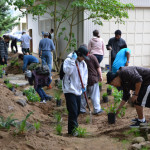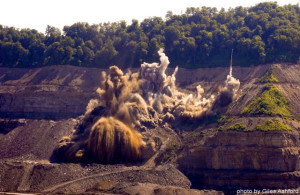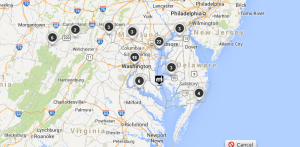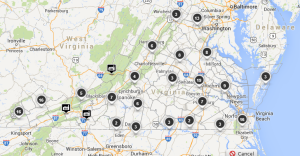“Regional Priorities” at SMC
For the new Formation Building, the folks behind LEED (the U.S. Green Building Council and its affiliate Green Building Certification Institute – update: now called the Green Business Certification Institute) assess environmental priorities in regions across the country–called Regional Priority—for all projects seeking certification. Additional scorecard credits can be earned for projects achieving the identified Regional Priority (RP) wants. What makes the points “additional” is that the regional priorities are overlays, if you will, to credits that can be normally earned, such as any in the following list. It amounts to a double-credit.
Here’s how the RP credits in SMC’s zip code compare to those in Scottsdale, Arizona’s zip code:
21409 85250
On-Site Renewable Energy – min. 1% On-Site Renewable Energy – min. 3%
Optimize Energy Perf. – 40% New C. Development Density and Community Connectivity
Alt. Transport. – Pub. Trans. Access Alt. Transport. – Parking Capacity
Site Devel. – Protect/Restore Habitat Heat Island Effect – Non-Roof
Stormwater Design – Quality Control Water Efficiency – Landscaping
Innovative Wastewater Technologies Water Use Reduction
Generally, water and energy are premium commodities in Arizona due to climate and geography.
For the Formation Building, there are prospects for meeting 3-4 of 6 possible RPs.
 Stormwater Design – Quality Control – Our civil engineer says this credit is achievable, as I alluded to in my most recent post. County code
Stormwater Design – Quality Control – Our civil engineer says this credit is achievable, as I alluded to in my most recent post. County code  requirements just about dictates as much. For LEED credit, our stormwater management plan must promote infiltration through the use of bioswales (see images to right–double-click on either to enlarge) or rain gardens and treat stormwater runoff from the new building and site to the level of 90% of average annual rainfall. At St. Margaret’s, on-site treatment will be through a bio-swale, as presently contemplated. (Update: 3 LEED points have been awarded to the project.)
requirements just about dictates as much. For LEED credit, our stormwater management plan must promote infiltration through the use of bioswales (see images to right–double-click on either to enlarge) or rain gardens and treat stormwater runoff from the new building and site to the level of 90% of average annual rainfall. At St. Margaret’s, on-site treatment will be through a bio-swale, as presently contemplated. (Update: 3 LEED points have been awarded to the project.)
Site Development – Protect or Restore Habit – This credit is still under consideration and is currently marked in the scorecard with a question mark. The credit has to do with limiting construction disturbance to specific numbers of feet beyond the building perimeter, beyond walkways and surface parking and etc. (Update: this credit was not feasible.)
On-Site Renewable Energy – This credit is under consideration and is currently marked in the scorecard as a maybe. Proposals for on-site renewable energy/solar at St. Margaret’s include two alternatives to be located at the south end of the field. These have been most recently described in an article by Stacia Bontempo in “The Spire.” (If you missed it, click here, then scroll down to pp. 11-12.) Were the parish to embrace the lessening of GHGs (greenhouse gasses) emitted by the new building through renewable energy sized to about 100% of demand, as many as 9 points could be earned—a major impact on the LEED certification level possible.
Optimize Energy Performance – 40% New Construction – Object here is to be able to simulate a whole building energy savings of at least 40% against the baseline building performance according to a nationally recognized ASHRAE (American Society of Heating, Refrigerating and Air Conditioning Engineers) standard. With the more efficient VRV system planned for the Formation Building, our mechanical engineer is hoping for a 36% improvement. That’s close, and we’re just entering the Design Development, where a full-blown energy model to be developed may, just may show the way to 40%. (Update: at 22.1% more efficient against the benchmark, the project falls way short of this requirement.)
As to the RPs we won’t achieve, SMC’s suburban location removes from play the idea of public transportation. To claim Innovative Wastewater Technologies, potable water use in the new building for conveyance of building sewage would have to be reduced by 50%. When I advanced the idea of installing waterless urinals, a cry of “they smell” took that out of play also.

“This Just In…” Did you hear or read the good news in The Washington Post that GHGs over the continental U.S. declined by 4.5% from 2011 to 2012? How’d that happen? The leading answer: the utility industry has continued to switch from coal to natural gas for electricity production. For those who love mountain tops as arranged by Mother Nature rather than rearranged by humankind, using less coal could be a very good thing.
This doesn’t mean we should let the pedal off the metal.
It’s estimated that some 31% of all GHGs in the U.S. are emitted by power plants alone. See the EPA’s GHGRP 2012: Reported Data. The emitters located in Maryland and Virginia are shown on these maps.


(Now I know for sure why the air overhead is so lousy, given the prevailing southeasterly winds plus tailpipe emissions from NoVa.)
While natural gas used to fire utility plants is great, exploring for it entails methane gas leaks. I didn’t know ‘til reading it in the story that methane gas is 20 times more effective at trapping global-warming-causing heat in the atmosphere than are CO2 emissions. So exploration must be done very diligently.
Pressure from the EPA has caused this switch by utility companies to natural gas rather than coal for raw power. Some are enraged by the EPA’s authority, and plenty worried about the proposed regulation of the CO2 emissions by existing power plants.
So, back to what St. Margaret’s will do about GHGs from the new building? We get to choose. There’s enough land to account for its—renewable—energy production. Make your voice heard, either way. It’s as much your parish as the next guy’s! Still don’t know what to do? Pray about how God would want us to demonstrate our committment to environmental stewardship in a setting of worship and peace. Then act. (Update: only rooftop-mounted PVs have been deemed acceptable.)
